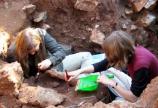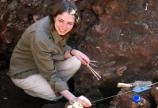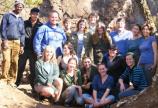Anthropology Field School students uncover fossils In 'Cradle of Humankind', South Africa
- Anne MacLaurin

It’s not every day that an undergrad can discover a 1.5-million-year-old human fossil; but that’s just what happened to UVic anthropology students Anne Tuominen and Elizabeth Hannah.
They were among a dozen anthropology undergraduate students who participated in a unique field school led by UVic Professor April Nowell (anthropology) and Dr. Colin Menter of the University of Johannesburg. They spent 14 days in July in South Africa in a region known as the “Cradle of Humankind” at a World Heritage Site called Drimolen.
For two weeks, the students worked alongside experts digging through the third-richest fossil site in South Africa, dating back 1.5 million years in hominin (early human) history. What makes the Drimolen site especially unique is the large number of infant hominin fossils. Experts believe the area was used as a sleeping site, so many of the discoveries are of very young children and infants.
“Fine screening techniques contribute to the rich discovery of neonate fossils at the site,” says Nowell. “The technique allows us to find even the smallest deciduous (baby) teeth.”
On the second day of the dig, Tuominen and Hannah
made an unbelievable discovery.
“We found a tiny hominin ulna fossil, dating back 1.5 million years,” says Hannah, “It was nerve-wracking, exciting and unbelievable—we had no idea what it was until we had uncovered most of it, and we were very thankful that we hadn’t damaged it.”
“Finding such a fossil was an unbelievable experience and far more excitement than I was prepared for on the second day of excavation,” says Tuominen. “It was a really incredible way to start the field school.”
“The students’ discovery was the first fossil to be uncovered for that excavation season,” says Nowell. "It was a small piece of bone, likely from an infant—a great addition to the Drimolen collection.”
After 12 days of excavation work, journal entries and lectures, the students were ready for a two-day game drive through the Pilanesburg Game Reserve (http://www.pilanesberg-game-reserve.co.za/). Starting out as the sun rose, Menter and Stephanie Baker (the field school’s TA and a zoologist) led the students through the game park pointing out giraffes, zebras, elephants, lions, hippos and other exotic animals.
The field school also visited the world-renowned Transvaal Museum, where many of the most important fossils in the world are stored, and the University of Witwatersrand, where they were introduced to the first australopithcine fossil ever found, the Taung Child, discovered in the 1920s.
“I wanted the students in the field school to have a variety of experiences,” says Nowell, “going beyond text books and learning first-hand about famous anthropological discoveries. The students were able to see fossils that 80 per cent of my colleagues have only ever seen in text books,” she adds.
Nowell hopes to continue exploring the hominin fossil site at Drimolen in July 2012 with another group of field school students. On Nov. 21, Nowell will hold an anthropology colloquium about field schools from 11:30 a.m. to 1 p.m. in the MacLaurin Building, Mac D103.



